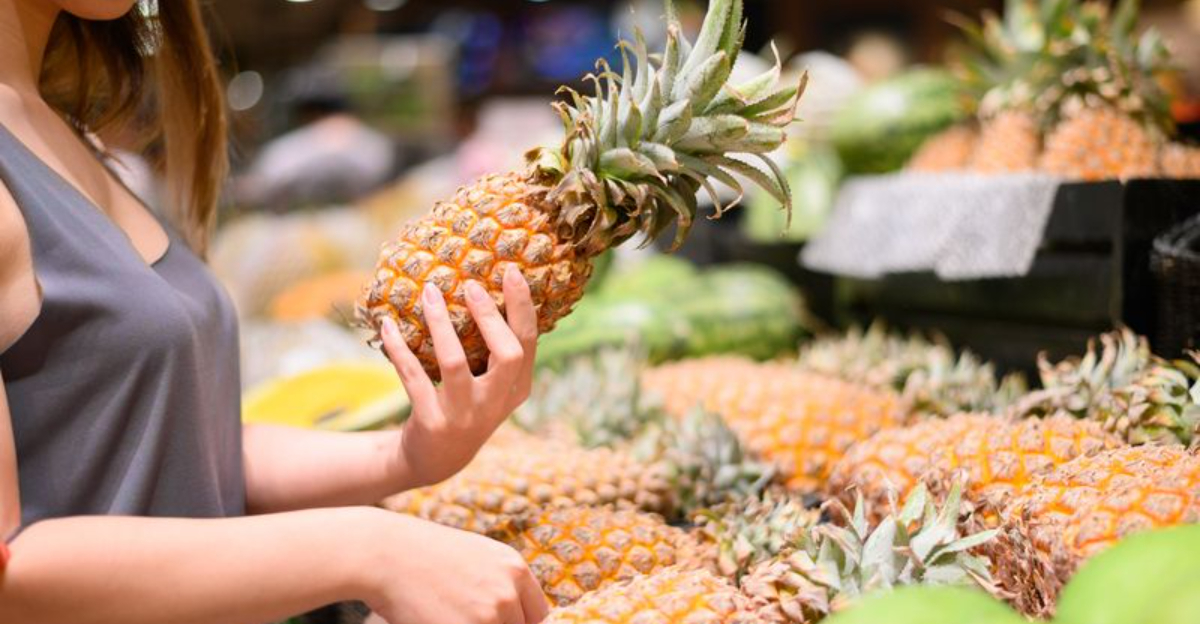8 Ways To Pick The Best Pineapple At The Store, According To Experts

Picking the perfect pineapple can sometimes feel like a tropical treasure hunt! I’ve stood in the produce aisle, utterly stumped about which spiky fruit to pick.
After a few too many disappointing, under-ripe pineapples that left me with more frustration than flavor, I decided it was time to learn from the experts.
Through trial, error, and plenty of juicy research, I’ve gathered some top-notch tips to ensure you choose the sweetest, ripest pineapples every time. With these expert-approved strategies, you’ll go from pineapple novice to selection pro faster than you can say “piña colada smoothie.”
1. Sniff the Bottom for Sweetness
Last Tuesday, I blindfolded myself in the produce section (earning some strange looks) to test this trick—and it works! A ripe pineapple releases a sweet, tropical aroma from its base. If you can’t smell anything, it’s probably not ready to eat.
Fruit experts agree that the stronger the sweet smell, the riper the pineapple. No need for fancy equipment or complicated tests here. Your nose knows best!
Fun fact: Pineapples actually stop ripening once they’re harvested, unlike bananas or avocados. So what you smell is what you get—choose wisely!
2. Give the Leaves a Gentle Tug
“Ouch!” That was me, learning this technique the hard way. The crown’s leaves should release with minimal resistance if the pineapple is ripe. Grab the center leaf and pull—if it comes out easily, you’ve struck gold!
Pineapple farmers have used this method for generations. The science behind it? As pineapples ripen, the connection between leaves and fruit naturally weakens.
I’ve saved countless friends from unripe disappointment with this simple test. Just remember to be subtle about it in the store—you’re testing, not vandalizing the produce section!
3. Check for Plump, Flat “Eyes”
Those little hexagonal patterns covering the pineapple? They’re actually called “eyes,” and they’re your window into ripeness! Perfectly ripe pineapples have flat, plump eyes rather than sunken or pointed ones.
My produce manager friend Miguel taught me this gem. “The eyes should be consistent in size and relatively flat across the fruit,” he explained while demonstrating on a display of Hawaiian Gold pineapples.
Take a moment to run your fingers across these patterns. They should feel slightly yielding but not mushy. Avoid fruits with dried-out or shriveled eyes, as they’re likely past their prime.
4. Weigh It in Your Hands
Hefty fruits win prizes! A juicy, ripe pineapple feels surprisingly heavy for its size. I discovered this trick after my Hawaiian vacation where a roadside fruit vendor blindfolded me and had me choose between two identically-sized pineapples.
The science is simple: more juice equals more weight. Compare similar-sized pineapples by picking them up. The heavier one typically contains more juice and sugar, meaning better flavor.
Size doesn’t always matter with pineapples—I’ve had tiny ones that tasted like tropical heaven. Focus on the weight-to-size ratio instead of just grabbing the biggest one on display.
5. Look for Golden-Orange Exterior Color
Color-coding your pineapple selection might just change your fruit game forever! The perfect pineapple wears a golden-orange jacket, not a completely green one. My first clue came from watching my grandmother shop—she always ignored the all-green ones.
The color should extend from the bottom upward. Some green on top is fine, but a pineapple that’s totally green hasn’t developed its full sweetness yet. Conversely, avoid pineapples with dark orange-brown spots or extensive bruising.
Did you know? That gorgeous golden color develops as the natural sugars in the pineapple increase. It’s nature’s way of signaling peak deliciousness!
6. Press the Shell for Slight Give
Squeezing pineapples changed my fruit-shopping life! A perfectly ripe pineapple has a shell that yields slightly to pressure—not rock-hard but definitely not mushy. Think of it as the Goldilocks of fruit firmness.
The first time I tried this technique, I pressed too hard and left a thumb-shaped bruise. Gentle pressure is key! If the pineapple feels like a brick, it needs more time. Too soft? It’s overripe.
Produce experts recommend testing several spots around the fruit’s middle. The give should be consistent all around, indicating even ripening throughout the pineapple. Your fingers will thank you later when cutting becomes a breeze!
7. Examine the Bottom for Mold
Flip that tropical beauty over! The bottom of a pineapple reveals secrets that the crown cleverly hides. I learned this the hard way after cutting into what looked like a perfect specimen, only to find fuzzy surprises inside.
A healthy pineapple base should be firm, free from mold, and have a slight sweet smell. Avoid any with leaking juice, white/blue fuzzy spots, or an odd fermented odor. These are all red flags signaling spoilage.
My fruit vendor confessed this is where they hide the less-than-perfect pineapples on display. Sneaky! Make this bottom-check your final test before committing to your prickly purchase.
8. Feel for Firm, Intact Leaves
Crown me the pineapple queen! The leafy top tells more than you’d think about what’s inside. Fresh, firm, green leaves signal a recently harvested pineapple. Bonus points if the crown stands tall and proud!
I once grabbed a pineapple with browning, droopy leaves because it was on sale. Big mistake! The fruit inside was dry and flavorless. Now I know better—those leaves are like the pineapple’s vital signs monitor.
Avoid specimens with dry, brown, or brittle leaves. While some minor discoloration at the very tips is normal, excessive browning suggests the fruit has been sitting around too long, losing moisture and flavor with each passing day.
